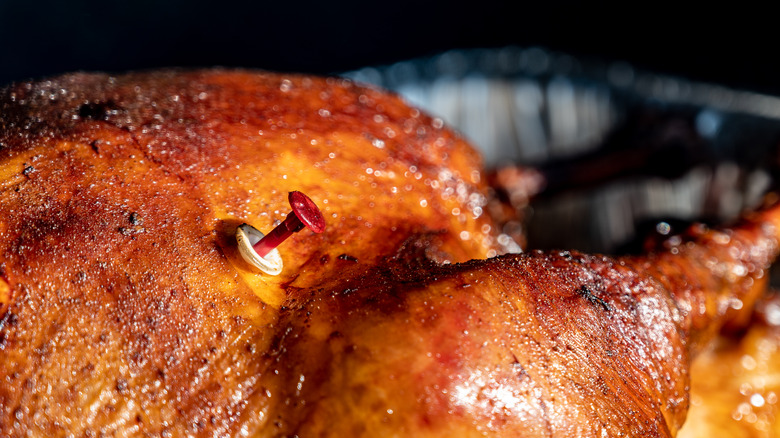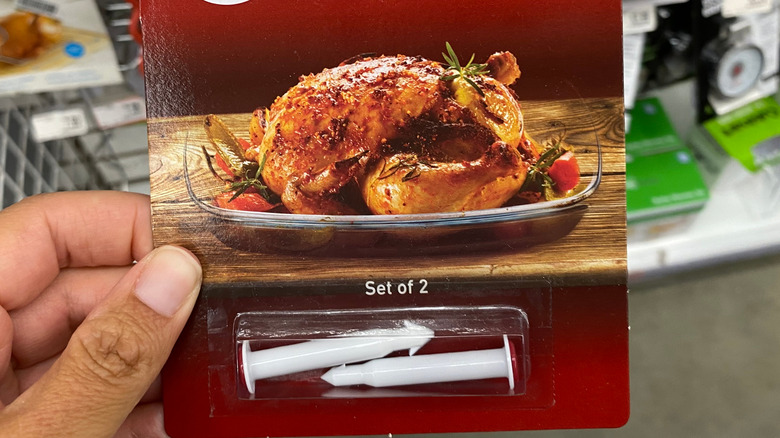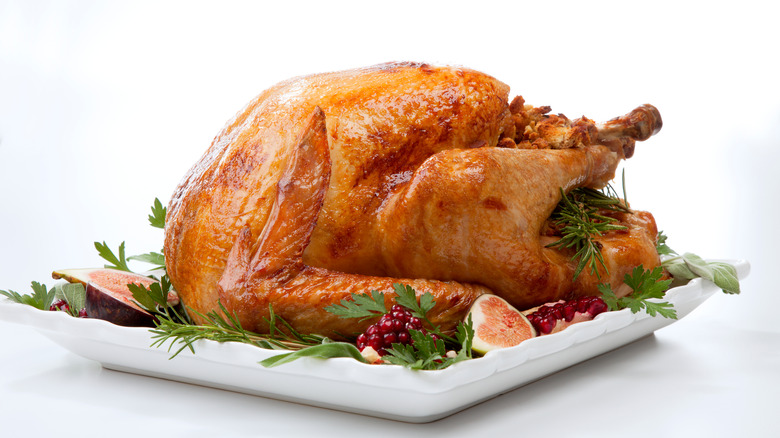Why You Shouldn't Trust The Pop-Up Timer In Your Thanksgiving Turkey
Just as there may be more than one way to skin a cat, there is more than one way to work out whether a Thanksgiving turkey is ready to come out of the oven. You can twist a drumstick ever so slightly to see if the leg gives at the knee, stab the roasting bird with a fork or knife to see if its juices run clear, or use a thermometer to see if the bird's internal temperature is at 165 degrees, per Los Angeles Times. But few, if any chefs these days will recommend that you use the plastic pop-up timer to test the bird for doneness.
Those of us over a certain age can be forgiven for thinking all turkeys were born and bred to sport a plastic pop-up button, mainly because it always seemed that way. The Washington Post says turkeys began sporting the widget in the sixties, and it was a way to help cooks at home serve up a respectable bird, especially during a time when recommendations for time-per-pound were considered to be unreliable. Now, the script has been flipped and people no longer recommend trusting the built-in timer, but why?
How it works
The inventors behind the pop-up plastic timer had two objectives when they first thought of creating something that could help home cooks time their roasting birds properly: to teach home cooks how to cook turkeys so they were edible, and by extension, to help promote turkey sales beyond the Thanksgiving period, per The Washington Post. Because the original timer was unreliable and couldn't be counted on to pop at the right temperature, or pop out of the bird altogether, the inventors couldn't get food experts to buy into the idea, and they eventually spun off their pop-up timer before selling the idea to 3M.
Today, The Washington Post says the design patent for the pop-up gadget is owned by Volk Enterprises, and it is made with four different parts: a barrel, a red plunger, a spring, and blob of food-grade wax. The thermometer is activated when the bird reaches a preset temperature because it melts the wax, which releases spring and lets the cook know the bird is ready. But that's where the main problem lies.
Per Huffpost, the pop-up timer is set to go off when the wax melts at between 180 to 185 degrees Fahrenheit, which is far hotter than the internal 165 degrees that the Food and Drug Administration considers to be a "safe" temperature for the bird. And even with a pop-up thermometer, the FDA says you still need a thermometer to check the turkey anyway.
Experts explain why they don't trust pop-up thermometers
Food experts like Harold McGee are not fans of the pop-up thermometer because it usually doesn't pop until the turkey is overcooked, per The Washington Post. McGee points out that the whole bird does not cook consistently because of its cracks and crevices, thick sections of muscle at the breast and thighs, and thin sections at the wings. So while the section nearest to the pop-up thermometer might be at 180 degrees Fahrenheit (overcooked) other portions might be underdone.
In fact, Consumer Reports tested a few of the thermometers and they popped well before the bird reached the safe temperature of 165 degrees — they actually indicated the birds were cooked at about 139.5 degrees. In her guide for making the perfect roast turkey, Martha Stewart gives the pop-up thermometer a hard pass. Instead, she recommends home cooks use a meat thermometer inserted at the thickest part of the thigh.
If you're wondering what to do with the pop-up gadget — you can either throw it out or if you stick to Butterball turkeys, you won't encounter them at all, per The Washington Post.


